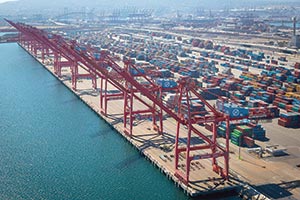Largest Ever Ship Line Failure Triggers Broad Cargo Turmoil

This story appears in the Sept. 12 print edition of Transport Topics.
Truckers and the entire global shipping supply chain faced a broad array of complicated choices last week arising from Hanjin Shipping Co.’s bankruptcy that has left tens of thousands of shipments in limbo — stranded at sea, idle in ports or a burden for truckers.
Seoul, South Korea-based Hanjin, which is seeking court permission to restructure, told a Korean court last week $14 billion worth of cargo is stuck, just on ships.
The bankruptcy was the largest ever in the ocean- shipping industry, said Bernard Vaughan, a veteran shipping and intermodal attorney, who is chief legal officer at container lessor Flexi-Van Corp.
“There are innumerable parties that can arrest and levy on the debtor’s property in the United States,” Hanjin said in its request to a U.S. federal court, emphasizing the variety of creditors whose assets are at risk. “These parties include, but are not limited to, fuel providers, ship owners [where the debtor is a charterer], terminals, port pilots, trucking companies, repair vendors, rail companies and container lessors.”
Hanjin ranks No. 23 on the Transport Topics Top 50 list of the largest global freight companies and is larger than all but three U.S. trucking companies.
Last week, it won a provisional U.S. Bankruptcy Court ruling that could prevent the company’s ships from being seized by creditors if they docked, potentially leading to unloading and moving cargo.
However, at press time, the Marine Exchange of Southern California, which monitors ship traffic in the region, reported that seven Hanjin vessels are at anchor or en route to the United States.
At port terminals, complications abound.
Some are accepting empty containers, which helps truckers and frees up scarce chassis. Hanjin’s own terminal in Long Beach, California, was barring empty Hanjin returns but accepting other lines’ boxes. Maher Terminals at the Port of New York and New Jersey also barred Hanjin empties.
Loads were a somewhat different story, with multiple reports that truckers could pick up Hanjin loads as long as someone paid port charges, ranging up to $350.
Curtis Whalen, executive director of American Trucking Associations’ Intermodal Motor Carriers Conference, said truckers are being saddled with daily chassis and container usage fees that normally would be paid by others.
“The chassis is stuck on with a container on top, and the trucker can’t get rid of either one,” Whalen said. “There have been all kinds of pronouncements, but there is no clear legal answer yet about who will pay for what. This will take forever to sort out.”
Vaughn, who said “they [Hanjin] owe us a fortune,” highlighted the importance of terminals’ refusing to take back Hanjin empties but noted that his firm isn’t getting paid by the ocean carrier, either.
Whalen said a number of his members are shunning Hanjin business if they can because they don’t want the financial exposure.
He said each decision about whether to move a box has to be made individually based on competing interests between the trucker’s exposure and the future impact on customer relationships.
“It’s like a giant game of tag,” said Marcia Faschingbauer, CEO at drayage provider Excargo Services. “We have to be more careful and more certain what we are latching on to.”
Ocean carrier alliances are another complication.
Reports from the Pacific Northwest and elsewhere indicated alliance ships with Hanjin cargo operated by companies such as Japan’s NYK Line were being unloaded, but Hanjin cargo pickups weren’t being allowed unless port and terminal charges were paid.
The precise amount of affected cargo isn’t known, but the company’s monthly average totals 86,000 Hanjin import 20-foot cargo units at its 10 largest ports, according to research service Datamyne.
Regulators are involved, too.
The Federal Maritime Commission last week signaled its interest, saying it is “particularly interested in learning of any conduct by any regulated entity that may violate the Shipping Act.”
So are importers.
“There is millions of dollars worth of merchandise that needs to be on store shelves. Some of it is sitting in Asia waiting to be loaded on ships, some is already aboard ships out on the ocean and some is sitting on U.S. docks waiting to be picked up,” said National Retail Federation Vice President Jonathan Gold, who asked transport providers to work together to move the cargo.
A report from British consultant Transport Intelligence last week offered some hope, saying Hanjin’s parent, Hanjin Group, is planning to pump some funds into the bankrupt carrier.
“Even in the better scenario where the owners and the South Korean government finally step in to revive the container line, delay is still one of the biggest threats,” the report said.
Railroads are suffering, too. Union Pacific last week said it expects losses of 1 cent per share. That’s about $8 million based on its latest share count.
Hanjin losses mounted for the past three years, though some rivals turned profits until freight volumes dropped last year. But profits evaporated as carriers cut prices to fill their ever-larger ships.
“Hanjin was sort of caught in the middle as the industry suffered terrible losses,” Tioga Group shipping consultant Dan Smith said. “They didn’t invest to lower their costs by using megaships to the extent that others did. It was teetering for months. The question now is, who is the next carrier to fall?”
Staff reporter Ari Ashe contributed to this article.

